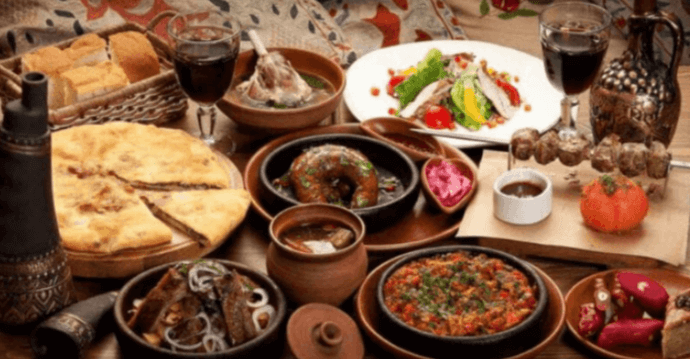gruzinski kuxnia: The Art of Georgian Cheese Making

Georgian cuisine, known as Gruzinski Kuxnia, offers a delectable window into the country’s rich cultural heritage and diverse geographical landscape. With its unique blend of flavors influenced by European and West Asian cultures, Georgian food is not just about nourishing the body but also celebrating community and tradition. This article delves into the foundational aspects of Georgian culinary traditions, exploring everything from staple ingredients and iconic dishes to regional variations and modern interpretations.
The Foundations of Georgian Culinary Traditions
Georgian culinary traditions are deeply rooted in the country’s history and geography, with each invasion and trade route bringing new ingredients and methods that have enriched its cuisine. The integration of spices and techniques from the Silk Road has given Georgian food its distinctive character, which is both spicy and subtly sweet. The traditional Georgian feast, or “Supra,” exemplifies the communal and celebratory nature of dining, where food and wine play a central role in bonding and cultural expression.
Essential Ingredients in Georgian Cooking
At the heart of Georgian cuisine are ingredients like walnuts, pomegranate, and aromatic herbs which define its unique flavor profile. Georgian dishes extensively use walnut sauce, and the pomegranate adds a tart sweetness to salads and stews. The country’s varied climate allows for a wide range of herbs, including tarragon, coriander, and mint, essential for adding depth and freshness to dishes.
The Art of Georgian Cheese Making
Cheese is a staple of Georgian diet, with varieties like Sulguni and Imeretian cheese being central to many dishes. The traditional cheese-making process is a craft passed down through generations, involving curdling milk and then ripening the cheese in special temperature-controlled environments, which adds a distinctive tang and texture that is integral to Georgian cuisine.
Iconic Georgian Dishes
Georgian cuisine is known for its variety of dishes that cater to every palate, from meat lovers to vegetarians.
Khachapuri – More Than Just Cheese Bread
Khachapuri, a cheese-stuffed bread, varies by region but consistently remains a beloved icon of Georgian cuisine. Whether it’s the boat-shaped Adjarian khachapuri, filled with cheese and topped with a raw egg and butter, or the circular Imeretian style, khachapuri is a staple in Georgian diets and a source of national pride.
Khinkali: The Technique of Georgian Dumplings
Khinkali, Georgian dumplings filled with spiced meat, herbs, and broth, are a test of culinary skill and etiquette. The technique involves carefully folding the dough to contain the broth, and they are traditionally eaten by hand, with diners competing to consume them without spilling a drop.
Georgian Stews and Grills
Chakhokhbili, a stew made with chicken and fresh herbs, and Mtsvadi, skewered and grilled meat, are dishes that showcase the rustic side of Georgian cuisine. These hearty dishes reflect the Georgian love for slow-cooked, flavorful meals that are shared around a communal table.
The Georgian Feast – Supra
The Supra is a traditional Georgian feast that is as much a culinary event as it is a cultural ceremony.
The Role of Toastmaster or ‘Tamada’
The Tamada plays a crucial role in guiding the supra through a series of toasts and speeches, reflecting the Georgian values of hospitality, friendship, and community.
Sequence of Dishes and Drinks at a Supra
A typical supra features a sequence of dishes accompanied by Georgian wine, beginning with cold appetizers and salads, moving through hot dishes, and ending with fruit and dessert, each paired with specific toasts.
Georgian Wines and Spirits
Georgia’s 8,000-year-old winemaking tradition is integral to its cultural identity, with traditional methods still in practice.
Traditional Georgian Winemaking Methods
The use of Qvevri, large earthenware vessels buried underground, in winemaking distinguishes Georgian wine with its earthy tones and robust flavors. Georgian wines, like the amber-colored Rkatsiteli and red Saperavi, are gaining international acclaim for their unique production methods and flavors.
Famous Georgian Spirits and Their Distillation
Chacha, a potent grape brandy, is another traditional Georgian spirit, distilled from grape pomace, and enjoyed both in celebrations and everyday life.
Regional Variations in Georgian Cuisine
Georgian cuisine reflects the diverse landscapes and climates of the country, from the mountains to the Black Sea coast.
Mountainous vs. Coastal Georgian Cuisine
The mountainous regions favor hearty, meat-based dishes that provide energy for the cold climates, while the coastal areas offer a variety of seafood dishes influenced by the Black Sea.
Unique Dishes from Various Georgian Regions
Each region of Georgia has its unique dishes that reflect local tastes and agricultural practices. For instance, the use of corn and kidney beans in dishes from the western region contrasts with the meat and dairy-heavy dishes of the eastern region.
Modern Georgian Cuisine
In recent years, there has been a resurgence of interest in Georgian cuisine, with chefs both in Georgia and abroad reinterpreting traditional recipes with modern techniques.
Fusion and Modern Interpretations
Modern Georgian chefs are experimenting with traditional ingredients to create innovative dishes that maintain the essence of Georgian flavor while presenting it in new forms.
Georgian Cuisine in the Global Dining Scene
Georgian restaurants are opening in major cities around the world, introducing people to its rich flavors and unique dining traditions.
Cooking Georgian Cuisine at Home
With the increasing availability of Georgian spices and ingredients abroad, it is easier than ever to bring the flavors of Georgian cuisine into your home.
Essential Recipes for the Home Cook
Basic Georgian recipes, such as Lobio (bean stew) and Ajapsandali (vegetable stew), can be easily adapted for home cooking, allowing anyone to explore Georgian flavors.
Tips for Sourcing Authentic Ingredients
For those looking to cook Georgian dishes at home, sourcing key ingredients like Georgian spices and cheeses can make a significant difference in achieving authentic flavors.
The Future of Georgian Cuisine
As Georgian cuisine continues to captivate food enthusiasts around the world, its future appears both promising and intriguing.
Preservation of Tradition vs. Innovation
The challenge for Georgian cuisine will be to maintain its traditional methods while embracing innovation and new techniques that can bring Georgian food to a wider audience.
The Role of Culinary Education in Georgia
Culinary schools in Georgia are nurturing new chefs who are fluent in traditional techniques but are also equipped to take Georgian cuisine into the future.
FAQs About Georgian Cuisine
- What makes Georgian cuisine unique?
- Georgian cuisine is distinguished by its use of unique spices, extensive use of nuts and cheeses, and the combination of sweet and savory flavors in many dishes.
- Can vegetarian dishes be found in Georgian cuisine?
- Yes, there are numerous vegetarian dishes in Georgian cuisine, including pkhali (vegetable pâté) and lobio (bean stew).
- How important is wine to Georgian dining?
- Wine is considered essential in Georgian dining and is typically consumed during meals, especially during a Supra.
- What are some must-try Georgian dishes for first-timers?
- First-timers should try Khachapuri, Khinkali, and Chakhokhbili to experience a range of flavors and preparations in Georgian cuisine.
- Are there any specific eating etiquettes in Georgian dining?
- Georgian dining often involves sharing dishes from a communal table, and it is customary to accept the bread and salt offered as a sign of hospitality.
- How can one best experience a traditional Georgian Supra?
- To truly experience a traditional Georgian Supra, participate in one hosted by a Georgian family or in a traditional Georgian restaurant where the customs and sequence of toasts are observed.
As Georgian cuisine continues to spread its wings globally, it offers a taste that is not only hearty and comforting but also rich with history and tradition. This culinary journey is a testament to the country’s resilience and its unwavering commitment to hospitality and community. Whether you’re a seasoned gourmand or a curious foodie, exploring Gruzinski Kuxnia is sure to be an enriching experience that delights the palate and nourishes the soul.





